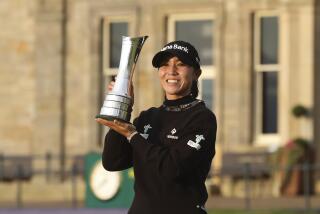Remotely Interesting
- Share via
SANDWICH, England — In 1934, Royal St. George’s was already 47 years old and the course was about to play host to the British Open for the seventh time. With layers of history, there come pages of tradition and some of it is laid on a little thick, as Gene Sarazen discovered.
Sarazen had already won the Open Championship in 1932 at Prince’s, but that didn’t mean much to the official at the clubhouse door of Royal St. George’s.
Scruffy fellows, those players.
Professional golfers, you must understand, were not allowed to set foot in the clubhouse, except during the Open Championship, when special provisions were made.
The competitors could enter, all right, provided they came in through the back door to use the locker room and find the toilets.
Sarazen went to the wrong door, the front door. There, he found his path blocked by an Open official. When the guard refused to budge, Sarazen did it for him, placing his hands on the man’s shoulders and simply picking him up and moving him out of the way.
For Sarazen, it was a simple way of dealing with a loose impediment.
Sixty-nine years later, the British Open is back at Royal St. George’s, where the door is wide open this time. The Open and Royal St. George’s are back in business again, after a 10-year break.
The course has been lengthened 246 yards for the Open and measures 7,106 yards. Eight new tees and a new green at the 550-yard 14th, pushed back 43 yards, are the changes most responsible for the greater length.
The 14th is played directly into the prevailing southwest wind. It’s called the “Suez Canal” because of the stream that crosses the fairway 330 yards from the tee. Out of bounds runs all along the right side of the fairway and two new pot bunkers have been added, about 70 yards short of the green, right in the middle of the fairway.
So Royal St. George’s looks different than when Greg Norman won the last Open here in 1993. Sandy Lyle won here in 1985 and Bill Rogers in 1981, which was the first time in 32 years that Royal St. George’s had hosted the Open, since Bobby Locke won in 1949.
Because there was a scarcity of hotels and the roads were inadequate, the venue was considered out of date. But a major new road system and better housing changed all that.
Even so, Royal St. George’s continues to enjoy a reputation as sort of a loner, hidden in solitude, no matter the situation. Ian Fleming did his best to change it, single-handedly. Fleming, who wrote the James Bond books, wrote about Royal St. George’s in “Goldfinger,” in a grudge match between Bond and Auric Goldfinger, the bad dude.
Fleming masked the identity of the course by calling it “Royal St. Mark’s,” but his description of the holes gave it away.
Of course, when “Goldfinger” became a motion picture, the scene was shot at Stoke Poges, a parkland course conveniently located near London and not the remote setting associated with Royal St. George’s.
That’s entirely in keeping with the way things go around here.
What is not in keeping is the weather. It has been unseasonably pleasant and dry, at least up to this week.
The high temperatures are forecast to run from the high 60s to the low 70s for the week with a chance of showers on Wednesday and Thursday.
The course was born in 1887, the idea of an Edinburgh native, Laidlaw Purves, an ophthalmologist who probably wouldn’t believe his eyes about what they’re doing to his layout on the Kent coast for this year’s Open.
They’re actually making it a bit easier. Or so it seems, after the chairman of the tournament committee changed the course’s signature hole, the 497-yard fourth, which was made 29 yards longer and a par five.
David Pepper, the committee chairman, says his reasoning is not that the hole is too hard, but that they prefer a par-71 course instead of a par-70.
At Royal St. George’s, it proves once again that at this place, par for the course is relative.
Now, quick, check the front door, players may be trying to use it.
*
(BEGIN TEXT OF INFOBOX)
132nd British Open
*--* Thursday-July 20 at Royal St. George’s * Par: 71, 7,106 yards * Format: 72 holes, stroke play * Playoff: Four holes, stroke play * Purse: $6.24 million. Winner’s share: $1.12 million * Defending champion: Ernie Els, who outlasted Thomas Levet in the first sudden-death playoff in British Open history. Els, Levet, Stuart Appleby and Steve Elkington each finished at six-under-par 278. Appleby and Elkington were eliminated after the four-hole playoff, and Els won by saving par from a bunker on No. 18, the first sudden-death hole. Tiger Woods, going for the third leg of the Grand Slam, shot an 81 in the wind-ravaged third round and finished six strokes out of the playoff * Open champions at Royal St. George’s: J.H. Taylor (1894), Harry Vardon (1899, 1911), Jack White (1904), Walter Hagen (1922, 1928), Henry Cotton (1934), Reg Whitcombe (1938), Bobby Locke (1949), Bill Rogers (1981), Sandy Lyle (1985), Greg Norman (1993) * Tiger tales: Woods comes to the British Open without owning any of the major championships for the first time since the 1999 PGA Championship * Noteworthy: In the last 20 years, Woods, Mark O’Meara, Nick Price and Nick Faldo are the only players to have won at least two majors in one season * TV: Thursday-Friday, 4 a.m. to 4 p.m., TNT; Saturday, 4 a.m. to 6 a.m., TNT; 6 a.m. to 11:30 a.m., Ch. 7. Sunday, 6 a.m. to 8 a.m., TNT; 6 a.m. to 11:30 a.m., Ch. 7
*--*
More to Read
Go beyond the scoreboard
Get the latest on L.A.'s teams in the daily Sports Report newsletter.
You may occasionally receive promotional content from the Los Angeles Times.










